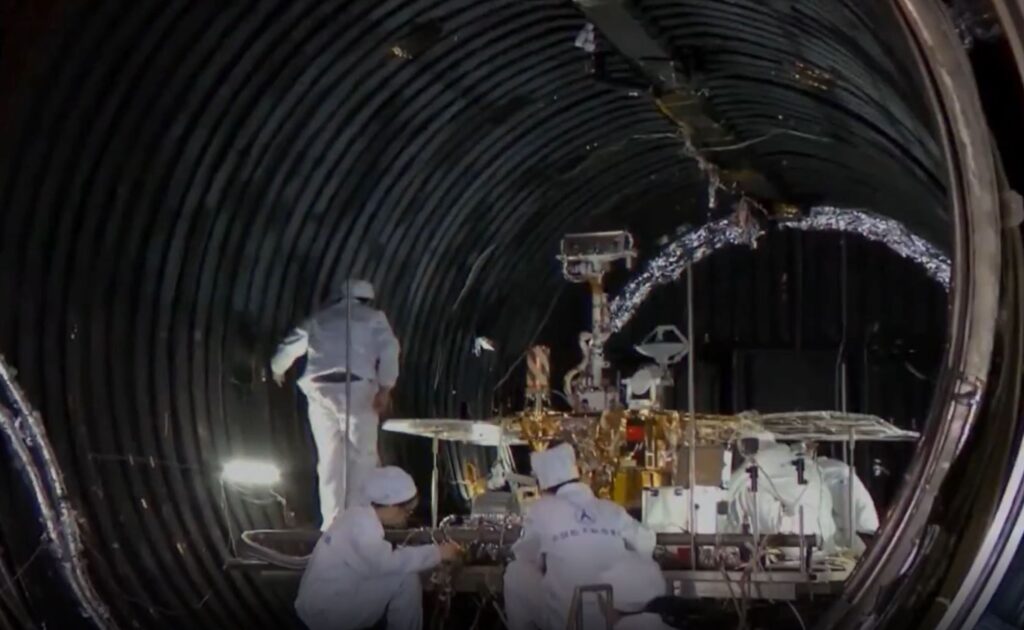Products You May Like
HELSINKI — China has named its first independent interplanetary mission Tianwen-1, with the combined Mars orbiter and rover spacecraft apparently proceeding towards launch in July.
The name and mission logo were unveiled at a China National Space Administration online ceremony to mark the 50th anniversary of the launch of the country’s first satellite. DFH-1 launched on a Long March 1 rocket from Jiuquan April 24, 1970, making China the fifth country to independently launch a satellite.
Tianwen-1, meaning ‘questions to heaven’, is taken from the name of a long-form poem by Qu Yuan, a poet born in the fourth century B.C., according to CNSA chief engineer Ge Xiaochun.
The ‘Lanxingjiutian’ logo includes representations of the Latin letter ‘c’, referring to China, cooperation, and the cosmic velocity required to undertake planetary exploration. Further Chinese planetary missions will also carry the Tianwen name.
China is understood to be planning a Mars sample return mission, a Jupiter orbiter and considering possible missions to icy giants and interstellar space. A joint near-Earth asteroid sample return and comet rendezvous mission has also been proposed.
Spacecraft delivered, rocket engines tested
Few details of the Tianwen-1 mission have been released so far. The Tianwen-1 spacecraft is expected to have a wet mass of around 5 metric tons. Launch on a Long March 5 launcher is expected from Wenchang early in the short launch window to Mars open in late July and early August.
The YF-77 liquid oxygen-liquid hydrogen engines for the Long March 5 passed tests in January. The same engines were the cause of the failure of the second Long March 5 launch in 2017.
Comprehensive software and hardware tests of the spacecraft were completed in March. The spacecraft has apparently been delivered to Wenchang Satellite Launch Center.
The test launch of the Long March 5B—currently expected in early May—will likely need to succeed for the Tianwen-1 mission to proceed. Following that mission, the Yuanwang-21 and -22 cargo vessels will collect the components of the Long March 5 for Tianwen-1 from Tianjin, north China, for delivery to Wenchang on the southern island of Hainan.
Tianwen-1 orbiter, lander details
The Tianwen-1 orbiter will be equipped with a high-resolution camera comparable to HiRise on board NASA’s Mars Reconnaissance Orbiter. It also carries a medium-resolution camera, subsurface radar, mineralogy spectrometer, neutral and energetic particle analyzers and a magnetometer. The orbiter will also play a relay role for the mission rover.
The roughly 240-kilogram solar-powered rover is nearly twice the mass of China’s Yutu lunar rovers. It will carry a ground-penetrating radar, multispectral camera, a Laser Induced Breakdown Spectroscopy instrument and payloads for detecting the climate and magnetic environment. The rover has a mission design lifetime of three Earth months. The rover will receive a name through a public vote closer to launch.
China has outlined two landing areas, with a candidate landing site in Utopia Planitia. The landing ellipse is understood to be around 100 x 40 kilometers. Site selection was driven by a range of factors including flight system engineering constraints and the challenges of entry, descent and landing (EDL) on the Red Planet, and the science goals of the mission.
The Tianwen-1 spacecraft is expected to reach Mars around February 2021. However, the rover landing attempt may not take place immediately. There are suggestions that the landing segment of the mission will be conducted months later, in April. This would allow mapping and observation of the landing site, despite the availability of high-resolution NASA imagery from HiRise.
The Tianwen-1 mission will join NASA’s Perseverance Mars 2020 rover and the United Arab Emirates’ Hope Mars orbiter, which this week shipped to its launch site in Japan, in launching during the July-August Mars launch window. ESA’s Rosalind Franklin ExoMars rover has been delayed to the next opportunity in 2022.

